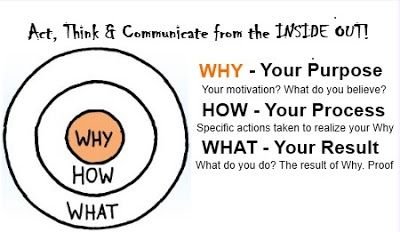As marketers, we have been taught and know that to be a success we need to know our "why". Motivational speakers and gurus are always telling us we need to know our why on a personal level. But how does this play out on a larger scale? What about companies and corporations? What and how did they do it to achieve their success and market penetration?
Although this isn't new, it's a very refreshing perspective on how successful companies have achieved market share. Simon Sinek codifies a pattern in which they use to consciously or subconsciously market their products. This is called The Golden Circle. This concept is able to explain why some organizations and leaders are able to inspire and others aren't.
In studying this pattern, it has become evident all great inspiring leaders and organizations in the world, think, act, and communicate the exact same way. It is also the complete opposite of everyone else. This idea explains why some companies and leaders are able to inspire and others can't. It boils down to three little words - Why? How? What? And in which order they are processed.

100% of people and organizations know what they do. Some know how, but very few know why. The why is not a matter of making a profit, that is classed as a result. It's more a case of what is your purpose or cause? What is your belief? Why does the organization exist? Why should anyone care? So the way we think, act and communicate is generally from the outside in. The why being internal is always fuzzy, so it's easier to focus on what and how which is clearer.
Inspired leaders and organizations, regardless of their size or industry, all think and act from the inside out. This is not an opinion but very much grounded in the principle of Biology. Not Psychology. It's actually in the brain. The human brain can be broken down into three major parts. The newest brain. It's what is called our Homosapien brain, or the neocortex and responds to the "what" level. This is responsible for all our rational and analytical thought and language.
The other two sections of the brain constitute our Limbic brains. These are responsible for our feelings, like trust and loyalty. It's also accountable for all human behavior and all decision making. It has no capacity for language. This is where the "why" and "how" comes into play.
When we communicate showing only "what" we have to offer, people will be well equipped with all the complicated information like the features and facts, however, it doesn't drive behavior and entices them to buy. You often hear people say "I know all the details and facts, but it just doesn't feel right". Why would they say that? It's because the decision part of the brain is not part of and doesn't control the language part. So it's all happening in the Limbic brain where feelings, emotions, trust and decision making reside.

We need to know why we do what we do. If the "why" is communicated first, people will respond with the decision making Limbic brain and may even become a loyal fanatical client who wants to be part of what we do. People will believe what you believe. People don't buy what you do, they buy why you do it. Explaining the why you do it proves what you believe.
As Simon explains:
The goal is to sell to people who believe what you believe. The goal is not just to hire people who need a job; it's to hire people who believe what you believe. I always say that you know, if you hire people just because they can do a job, they'll work for your money, but if they believe what you believe, they'll work for you with blood and sweat and tears.
He goes on to say;
The goal is not to do business with everybody who needs what you have. The goal is to do business with people who believe what you believe. People don't buy what you do; they buy why you do it. If you talk about what you believe, you will attract those who believe what you believe.
Notably, the other point Simon made was the Law of Diffusion of Innovation. Why is it important to attract those who believe what you believe? Statistics show that;
- 2.5% of the population are innovators - They get it wholeheartedly
- 13.5% are early adopters - Are comfortable making intuitive decisions by what they believe
- 34% are the early majority - Does not try something till someone else has tried it first
- 34% are the late Majority - Follow the early majority
- 16% are the laggards - They don't get it. They buy a touch phone because the rotary phone is now not available
So how do you find the people that "get it" before doing business with them instead of the ones that don't "get it"?
Go by the Golden Circle and work from the inside out. "Why" first, then "how" and "what".
There are people that are called leaders because they hold a position of power and authority. And then there are leaders who actually lead and inspire us. Whether its individuals or organizations, we follow those who lead, not because we have to, but because we want to. We follow those who lead and inspire, not for them, but for ourselves. And it's those leaders who start with "why" that have the ability to inspire those around them or find others who inspire them.
Many thanks to TED and Simon Sinek, the speaker who explores how leaders can inspire cooperation, trust, and change. https://startwithwhy.com/